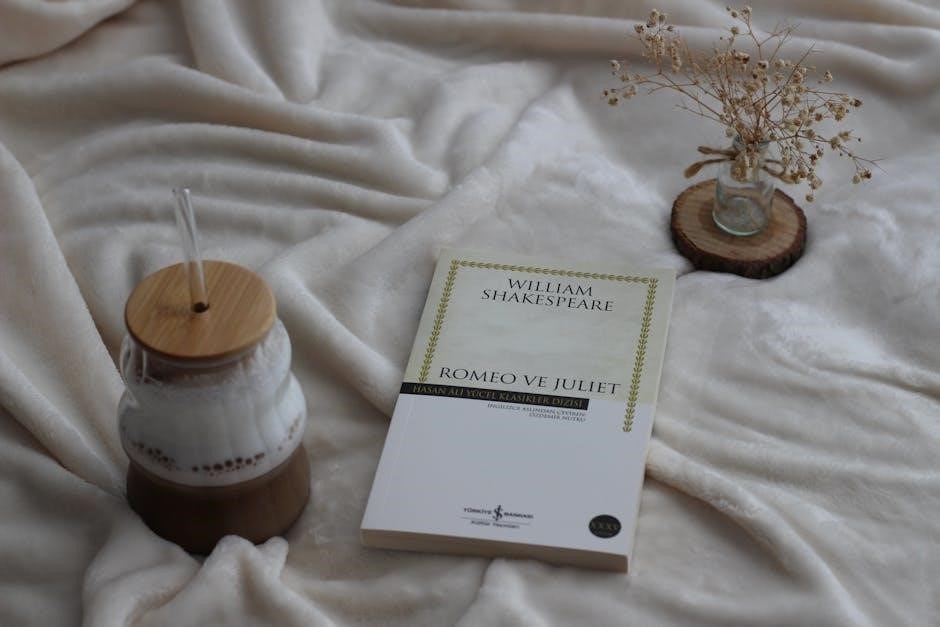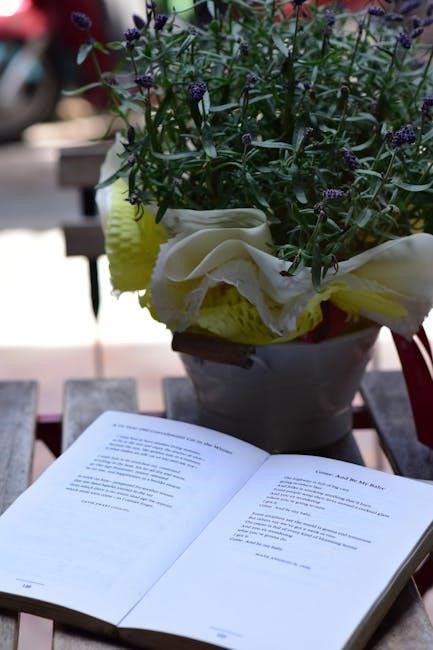Set in Salem, Massachusetts, 1692, Act 1 introduces the oppressive atmosphere of a Puritan community gripped by fear and superstition. The scene opens in Reverend Samuel Parris’s house, where his daughter Betty lies ill after a mysterious incident in the forest. The arrival of Reverend Hale, a witchcraft expert, escalates tensions, revealing the simmering hysteria and accusations that will drive the play’s tragic events. This act lays the foundation for themes of fear, guilt, and moral struggle, setting the stage for the devastating consequences of unchecked power and false accusations.
Overview of the Play and Its Historical Context
Arthur Miller’s The Crucible, set in Salem, Massachusetts, during the witch trials of 1692, explores themes of fear, hysteria, and the dangers of unchecked power. The play is a fictionalized depiction of real historical events, where mass paranoia led to the execution of innocent people accused of witchcraft. Miller wrote the play in 1953, drawing parallels between the Salem witch trials and the McCarthyism of his time, highlighting the destructive nature of false accusations and the erosion of justice in the face of fear and superstition.
The Significance of Act 1 in the Overall Narrative
Act 1 of The Crucible is pivotal as it establishes the foundation for the play’s themes and conflicts; It introduces key characters like Reverend Parris, Abigail Williams, and John Proctor, whose actions and motivations drive the narrative. The discovery of the girls dancing in the forest and Betty’s subsequent illness ignite the spark of hysteria. The arrival of Reverend Hale signals the start of a chain reaction, transforming a simple incident into a wave of accusations. This act sets the tone, foreshadowing the chaos and tragedy that will unfold, making it essential to understanding the play’s progression and its exploration of human frailty and societal collapse.

Setting of Act 1
Act 1 is set in Salem, Massachusetts, 1692. The scene opens in Reverend Parris’s small, dimly lit bedroom, creating a tense atmosphere. The nearby forest symbolizes forbidden behavior, contrasting with the confined, religious space inside.
The Physical Setting: Salem, Massachusetts, 1692
Act 1 unfolds in Salem, Massachusetts, during the spring of 1692. The primary location is Reverend Samuel Parris’s small, dimly lit bedroom, where Betty lies ill. The room reflects Puritan simplicity, with sparse furnishings and a sense of claustrophobia. Beyond the house lies the dense, mysterious forest, a symbol of the unknown and forbidden, where the girls danced. This contrasting setting establishes the play’s tension between the rigid, religious community and the untamed natural world.
The Historical Context of the Salem Witch Trials
The Salem Witch Trials of 1692 occurred amid mass hysteria fueled by Puritan beliefs, fear of the unknown, and social tensions. The trials were marked by unfounded accusations of witchcraft, leading to the execution of twenty people. The rigid societal norms and lack of due process created an environment where fear and superstition flourished. This historical backdrop is crucial for understanding the play’s depiction of a community consumed by irrational accusations and the devastating consequences of unchecked power and fear.
Main Characters Introduced in Act 1
Reverend Samuel Parris, a self-interested minister, his ill daughter Betty, and Abigail Williams, a manipulative housekeeper with a hidden past, are central to the plot. John Proctor, a respected farmer haunted by his affair with Abigail, emerges as a morally conflicted figure. These characters’ interactions set the stage for the play’s themes of guilt, revenge, and societal fear.
Reverend Samuel Parris and His Daughter Betty
Reverend Samuel Parris, a self-interested and anxiety-ridden minister, is deeply concerned with maintaining his reputation in Salem. His daughter, Betty, falls ill after being discovered dancing in the forest, sparking fears of witchcraft. Parris’s fixation on protecting his social standing drives his actions, as he seeks to deflect suspicion from his household. Betty’s condition worsens, adding to the family’s turmoil and the growing hysteria in the community. Parris’s rigid beliefs and fear of scandal underscore his complex, often unsympathetic character.
Abigail Williams and Her Motivations

Abigail Williams, a manipulative and vengeful former servant, is driven by a complex mix of unrequited love for John Proctor and a deep-seated resentment toward his wife, Elizabeth. Her dismissal from the Proctor household fuels her desire for revenge, which she achieves by exploiting the fear of witchcraft. Abigail’s accusations are calculated and strategic, aiming to eliminate Elizabeth and claim John for herself. Her cunning nature and ability to manipulate others highlight her central role in the escalating hysteria of Salem.
John Proctor, a respected Salem farmer, is introduced as a man of moral integrity but also with a flawed past. His affair with Abigail Williams creates internal conflict, as he struggles with guilt and redemption. Proctor’s entrance in Act 1 highlights his strong sense of justice and his disdain for hypocrisy, traits that will define his character throughout the play. His relationship with his wife, Elizabeth, and his past with Abigail are central to his motivations and the emerging conflicts in Salem.

Plot Summary of Act 1
The act opens with Betty Parris falling ill after dancing in the forest with Abigail and other girls. Reverend Parris discovers them, sparking fear of witchcraft. Abigail manipulates the situation, accusing Tituba of witchcraft to avoid blame. Reverend Hale arrives to investigate, escalating the hysteria. John Proctor’s past affair with Abigail is hinted at, setting the stage for future conflict. The act establishes the fear, accusations, and moral dilemmas that drive the play’s tragic events.
The Discovery of the Girls Dancing in the Forest
The act begins with the revelation that Betty Parris and Abigail Williams, along with other girls, were dancing in the forest, a forbidden activity in their strict Puritan community. When Reverend Parris discovers them, Betty faints, sparking fear of supernatural forces. Abigail, fearing repercussions, shifts blame to Tituba, the family’s slave, claiming she practiced witchcraft. This incident ignites the witchcraft hysteria, setting the stage for the accusations and paranoia that will engulf Salem. The forest, a place of forbidden behavior, becomes a central symbol of the play’s unfolding events.
The Arrival of Reverend Hale and the Beginnings of Hysteria
Reverend John Hale, an expert in witchcraft, arrives in Salem to investigate the mysterious circumstances surrounding Betty’s illness. His presence intensifies the community’s fear, as he is tasked with identifying supernatural forces. Hale’s systematic approach to uncovering witchcraft, combined with the villagers’ superstitions, fuels the growing hysteria. His interrogation of Tituba and the girls escalates the accusations, marking the beginning of a wave of fear and paranoia that will grip Salem. Hale’s authority inadvertently legitimizes the witch hunt, setting the stage for the play’s tragic events.
The Accusations Against Tituba and the Escalation of Fear
Tituba, Reverend Parris’s slave from Barbados, becomes the first to be accused of witchcraft. Under pressure, she confesses to practicing witchcraft and implicates others, fueling the growing hysteria. Her confession, though coerced, is taken as truth, highlighting the community’s willingness to believe in supernatural explanations for unexplained events. This marks the beginning of a wave of accusations, as fear and paranoia spread rapidly among the villagers. Tituba’s coerced admissions escalate the witch hunt, setting the stage for the devastating events that follow.
Themes in Act 1
Fear and hysteria dominate, as the community’s deep-seated anxieties are exploited, leading to irrational accusations and the breakdown of rational thought.
Guilt and redemption emerge through characters like John Proctor, whose past mistakes haunt him, while others seek forgiveness or justification for their actions.
The corrupting influence of power is evident, as authority figures exploit fear to maintain control, highlighting the dangers of unchecked power and moral compromise.
Fear, Hysteria, and the Dangers of Unchecked Power
Fear permeates Act 1, as the community’s deep-seated anxieties about witchcraft are exploited. Betty’s mysterious illness and the girls’ forbidden dancing spark hysteria, leading to irrational accusations. The arrival of Reverend Hale, an authority on witchcraft, amplifies the fear, creating a sense of impending doom. Unchecked power emerges as Parris and other leaders manipulate the situation for personal gain, highlighting how fear can be weaponized to control others. This unchecked power corrupts the community, setting the stage for the devastating consequences of mass hysteria and false accusations.
Guilt, Redemption, and Moral Struggles
Act 1 introduces the moral turmoil that drives the play’s characters. Reverend Parris’s fear of scandal reveals his self-interest, while Abigail’s jealousy and desire for John Proctor ignite a chain of deceit. Proctor, haunted by his past affair with Abigail, struggles with guilt and the weight of his moral failure. These internal conflicts set the stage for the redemption and sacrifice that will define their journeys. The act underscores how unresolved guilt can lead to devastating consequences, shaping the play’s exploration of human frailty and moral accountability.

Symbolism and Imagery in Act 1
Miller uses the forest and bedroom to symbolize forbidden behavior and vulnerability. The dimly lit room and Parris’s prayers create an ominous atmosphere, reflecting the community’s underlying fears and moral tensions.
The Forest as a Symbol of Forbidden Behavior
The forest in Act 1 symbolizes rebellion and secrecy, where the girls dance and conjure spirits, defying Puritan norms. It represents a space beyond societal control, where forbidden actions occur. The forest’s isolation and darkness contrast with the community’s rigid moral code, highlighting the tension between individual desire and collective repression. This setting foreshadows the chaos and fear that will engulf Salem, as the girls’ actions in the forest ignite the witch trials.
The Bedroom as a Symbol of Privacy and Vulnerability
The bedroom in Reverend Parris’s house serves as a private sanctuary, yet it reveals deep-seated fears and vulnerabilities. Betty’s illness and the family’s concerns about witchcraft expose personal anxieties hidden from public view. This intimate space symbolizes the fragility of individual lives and reputations, as private matters threaten to spill into the public realm, fueling the growing hysteria.

Conflict in Act 1
Tensions rise as fear of witchcraft spreads, driving accusations and betrayals. Personal secrets and guilt clash with public hysteria, igniting internal and external struggles among the characters.

Internal Conflict: Proctor’s Struggle with His Past
John Proctor grapples with guilt over his past affair with Abigail, which haunts him and fuels his moral dilemmas. His internal conflict stems from shame and a desire to redeem himself, clashing with his pride and the need to protect his reputation. This struggle intensifies as Abigail’s vengeful accusations threaten his family and community, forcing Proctor to confront his flaws and the consequences of his actions. His past mistakes loom over him, shaping his decisions and heightening the play’s tension.
External Conflict: The Community’s Accusations and Fear
The community’s accusations and fear create a tense atmosphere, as suspicion spreads rapidly among the villagers. Reverend Parris’s concern for his reputation sparks paranoia, while the arrival of Reverend Hale escalates the hysteria. The girls’ accusations, fueled by fear and manipulation, lead to a wave of panic, with neighbors turning against one another. The external pressure of societal judgment and the fear of witchcraft drive characters to act irrationally, fostering an environment of chaos and distrust that propels the play’s tragic momentum.

The Importance of Act 1 in Understanding the Play
Act 1 is crucial as it introduces key themes, sets the tone, and establishes conflicts that drive the narrative forward, providing foundational context for the play.
Establishing the Themes and Tone for the Rest of the Play
Act 1 introduces central themes of fear, hysteria, and moral corruption, setting the tone for the play. The discovery of the girls dancing in the forest and Betty’s illness create an atmosphere of tension and paranoia. John Proctor’s internal guilt and the community’s suspicion of witchcraft highlight the destructive power of unchecked fear. These elements establish the play’s somber tone and foreshadow the tragic consequences of false accusations. The act also reflects the broader theme of McCarthyism, emphasizing the dangers of mass hysteria and the erosion of rationality in the face of fear.

Introducing Key Conflicts That Drive the Narrative Forward
Act 1 establishes the central conflicts that propel the story. Reverend Parris’s fear of scandal and his daughter Betty’s mysterious illness create tension within his household. The arrival of Reverend Hale introduces the external conflict of witchcraft accusations, escalating community hysteria. Additionally, John Proctor’s internal struggle with his past affair with Abigail Williams is hinted at, foreshadowing future turmoil. These conflicts—both personal and societal—set the stage for the moral and emotional battles that will dominate the play, highlighting the destructive power of fear and deception.

Character Analysis
Reverend Parris emerges as a self-serving, fearful leader, prioritizing his reputation over truth. His paranoia and manipulation of events amplify the play’s tension and moral decay, highlighting his flaws and the community’s vulnerabilities.
Reverend Parris: A Man Driven by Fear and Self-Interest
Reverend Samuel Parris is portrayed as a man consumed by paranoia and self-interest. His primary concern is maintaining his reputation and authority in Salem, evident in his obsessive focus on his daughter Betty’s mysterious illness. Parris’s fear of public shame and suspicion of witchcraft reveals his deep-seated insecurity and moral hypocrisy. His actions are driven by a desire to protect himself rather than seek truth, showcasing a flawed character who embodies the hysteria and mistrust pervasive in the community.



